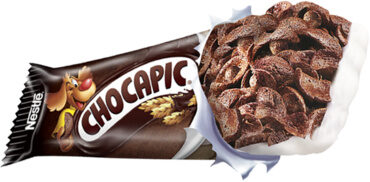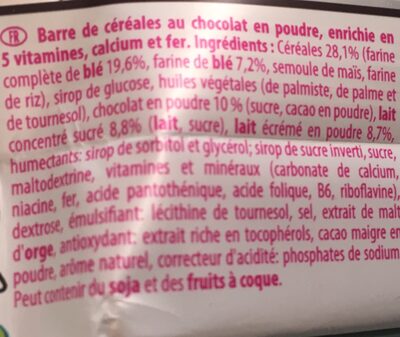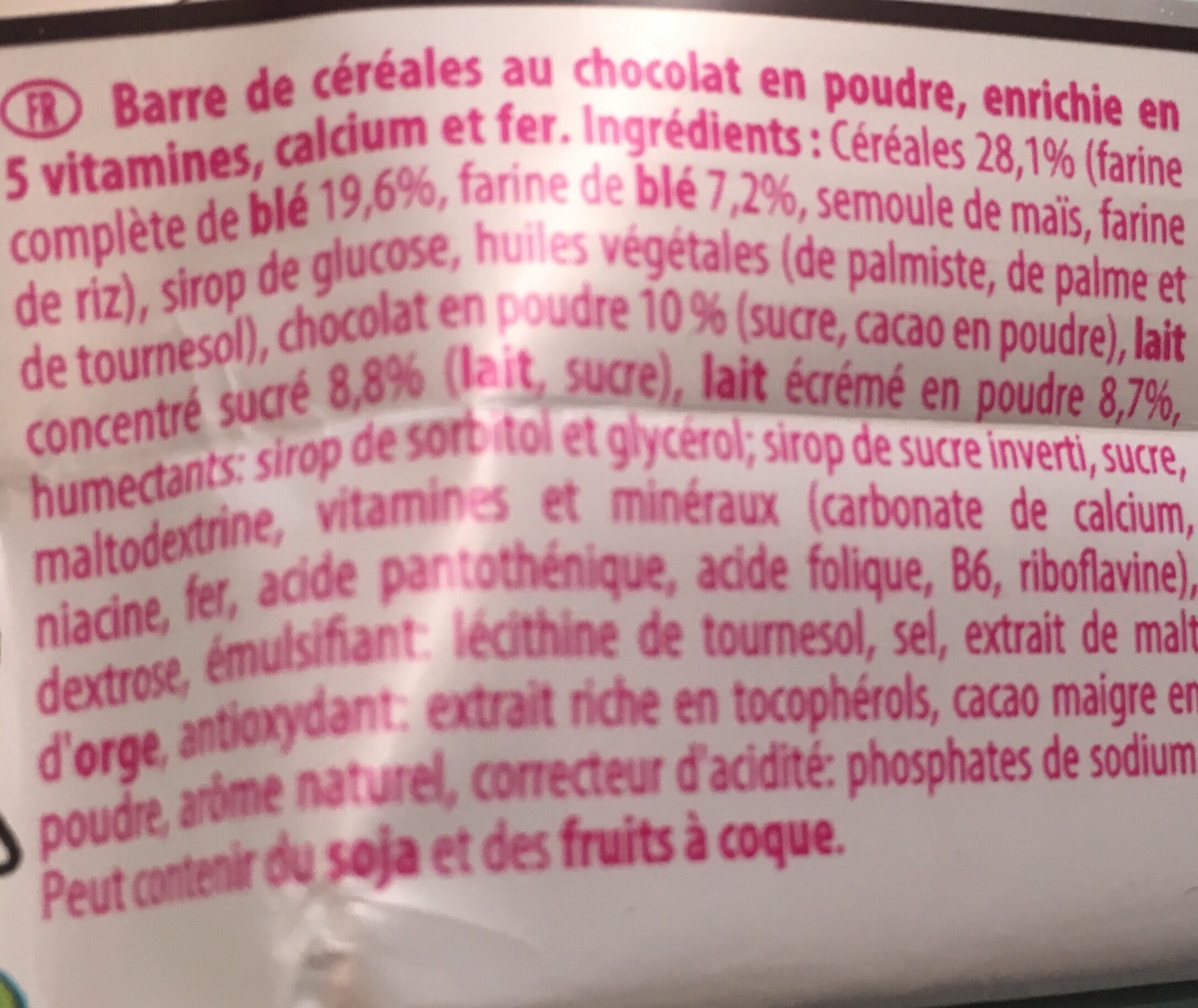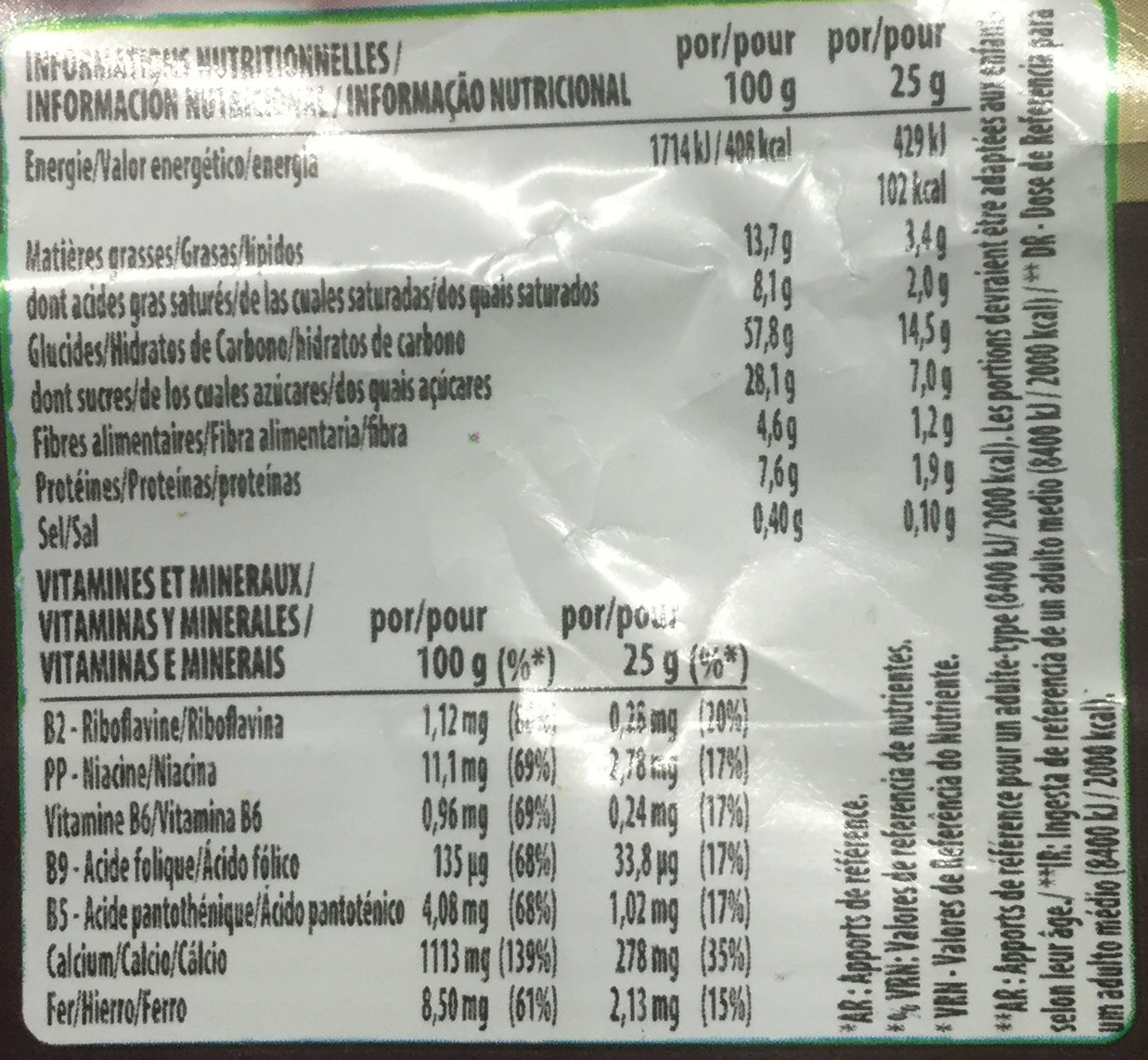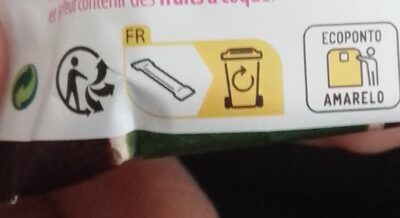Help us make food transparency the norm!
As a non-profit organization, we depend on your donations to continue informing consumers around the world about what they eat.
The food revolution starts with you!
CHOCAPIC barres de céréales - NESTLÉ - 25 g (1 barre)
CHOCAPIC barres de céréales - NESTLÉ - 25 g (1 barre)
This product page is not complete. You can help to complete it by editing it and adding more data from the photos we have, or by taking more photos using the app for Android or iPhone/iPad. Thank you!
×
Código de barras: 3387390325768 (EAN / EAN-13)
Common name: Barre de céréales au chocolat en poudre, enrichie en 5 vitamines, calcium et fer
Cantidade: 25 g (1 barre)
Empaquetado: en:Plastic, fr:Film plastique, nl:90, nl:Tidyman wastebasket
Categorías: en:Snacks, en:Sweet snacks, en:Bars, en:Cereal bars, en:Chocolate cereal bars
Etiquetas, certificacións, premios:
en:Green Dot
Tendas: Lidl, Carrefour Market
Matching with your preferences
Health
Ingredientes
-
36 ingredients
: Farine de blé complet 32%, sirop de glucose, chocolat en poudre 10,3% (sucre, cacao en poudre 3,3%), lait concentré sucré 9,3% (lait, sucre), humectants : glycérol, sirop de sorbitol ; lait écrémé en poudre 8,2%, sirop de sucre inverti, huile de tournesol, matière grasse végétale de coco, maltodextrine, carbonate de calcium, sucre, beurre de cacao, semoule de maïs, sel, farine de riz, émulsifiant : lécithine de tournesol ; extrait de malt d'orge, cacao maigre en poudre, arôme naturel de vanille, fer, antioxydant : extrait riche en tocophérols ; vitamines B3, B5, B6, B9 et B2.Alérxenos: en:Gluten, en:MilkTrazas: en:Nuts, en:Soybeans
Food processing
-
Ultra processed foods
Elements that indicate the product is in the en:4 - Ultra processed food and drink products group:
- Aditivo: E322
- Aditivo: E420
- Aditivo: E422 - Glicerol
- Ingrediente: Emulsifier
- Ingrediente: Flavouring
- Ingrediente: Glicosa
- Ingrediente: Almibre
- Ingrediente: Humectant
- Ingrediente: Invert sugar
- Ingrediente: Maltodextrin
Food products are classified into 4 groups according to their degree of processing:
- Unprocessed or minimally processed foods
- Processed culinary ingredients
- Processed foods
- Ultra processed foods
The determination of the group is based on the category of the product and on the ingredients it contains.
Aditivos
-
E322
Lecithin: Lecithin -UK: , US: , from the Greek lekithos, "egg yolk"- is a generic term to designate any group of yellow-brownish fatty substances occurring in animal and plant tissues, which are amphiphilic – they attract both water and fatty substances -and so are both hydrophilic and lipophilic-, and are used for smoothing food textures, dissolving powders -emulsifying-, homogenizing liquid mixtures, and repelling sticking materials.Lecithins are mixtures of glycerophospholipids including phosphatidylcholine, phosphatidylethanolamine, phosphatidylinositol, phosphatidylserine, and phosphatidic acid.Lecithin was first isolated in 1845 by the French chemist and pharmacist Theodore Gobley. In 1850, he named the phosphatidylcholine lécithine. Gobley originally isolated lecithin from egg yolk—λέκιθος lekithos is "egg yolk" in Ancient Greek—and established the complete chemical formula of phosphatidylcholine in 1874; in between, he had demonstrated the presence of lecithin in a variety of biological matters, including venous blood, in human lungs, bile, human brain tissue, fish eggs, fish roe, and chicken and sheep brain. Lecithin can easily be extracted chemically using solvents such as hexane, ethanol, acetone, petroleum ether, benzene, etc., or extraction can be done mechanically. It is usually available from sources such as soybeans, eggs, milk, marine sources, rapeseed, cottonseed, and sunflower. It has low solubility in water, but is an excellent emulsifier. In aqueous solution, its phospholipids can form either liposomes, bilayer sheets, micelles, or lamellar structures, depending on hydration and temperature. This results in a type of surfactant that usually is classified as amphipathic. Lecithin is sold as a food additive and dietary supplement. In cooking, it is sometimes used as an emulsifier and to prevent sticking, for example in nonstick cooking spray.Source: Wikipedia (Inglés)
-
E322i - Lecitina
Lecithin: Lecithin -UK: , US: , from the Greek lekithos, "egg yolk"- is a generic term to designate any group of yellow-brownish fatty substances occurring in animal and plant tissues, which are amphiphilic – they attract both water and fatty substances -and so are both hydrophilic and lipophilic-, and are used for smoothing food textures, dissolving powders -emulsifying-, homogenizing liquid mixtures, and repelling sticking materials.Lecithins are mixtures of glycerophospholipids including phosphatidylcholine, phosphatidylethanolamine, phosphatidylinositol, phosphatidylserine, and phosphatidic acid.Lecithin was first isolated in 1845 by the French chemist and pharmacist Theodore Gobley. In 1850, he named the phosphatidylcholine lécithine. Gobley originally isolated lecithin from egg yolk—λέκιθος lekithos is "egg yolk" in Ancient Greek—and established the complete chemical formula of phosphatidylcholine in 1874; in between, he had demonstrated the presence of lecithin in a variety of biological matters, including venous blood, in human lungs, bile, human brain tissue, fish eggs, fish roe, and chicken and sheep brain. Lecithin can easily be extracted chemically using solvents such as hexane, ethanol, acetone, petroleum ether, benzene, etc., or extraction can be done mechanically. It is usually available from sources such as soybeans, eggs, milk, marine sources, rapeseed, cottonseed, and sunflower. It has low solubility in water, but is an excellent emulsifier. In aqueous solution, its phospholipids can form either liposomes, bilayer sheets, micelles, or lamellar structures, depending on hydration and temperature. This results in a type of surfactant that usually is classified as amphipathic. Lecithin is sold as a food additive and dietary supplement. In cooking, it is sometimes used as an emulsifier and to prevent sticking, for example in nonstick cooking spray.Source: Wikipedia (Inglés)
-
E420
Sorbitol: Sorbitol --, less commonly known as glucitol --, is a sugar alcohol with a sweet taste which the human body metabolizes slowly. It can be obtained by reduction of glucose, which changes the aldehyde group to a hydroxyl group. Most sorbitol is made from corn syrup, but it is also found in nature, for example in apples, pears, peaches, and prunes. It is converted to fructose by sorbitol-6-phosphate 2-dehydrogenase. Sorbitol is an isomer of mannitol, another sugar alcohol; the two differ only in the orientation of the hydroxyl group on carbon 2. While similar, the two sugar alcohols have very different sources in nature, melting points, and uses.Source: Wikipedia (Inglés)
-
E420ii
Sorbitol: Sorbitol --, less commonly known as glucitol --, is a sugar alcohol with a sweet taste which the human body metabolizes slowly. It can be obtained by reduction of glucose, which changes the aldehyde group to a hydroxyl group. Most sorbitol is made from corn syrup, but it is also found in nature, for example in apples, pears, peaches, and prunes. It is converted to fructose by sorbitol-6-phosphate 2-dehydrogenase. Sorbitol is an isomer of mannitol, another sugar alcohol; the two differ only in the orientation of the hydroxyl group on carbon 2. While similar, the two sugar alcohols have very different sources in nature, melting points, and uses.Source: Wikipedia (Inglés)
-
E422 - Glicerol
Glycerol: Glycerol -; also called glycerine or glycerin; see spelling differences- is a simple polyol compound. It is a colorless, odorless, viscous liquid that is sweet-tasting and non-toxic. The glycerol backbone is found in all lipids known as triglycerides. It is widely used in the food industry as a sweetener and humectant and in pharmaceutical formulations. Glycerol has three hydroxyl groups that are responsible for its solubility in water and its hygroscopic nature.Source: Wikipedia (Inglés)
Análise dos ingredientes
-
en:Palm oil free
No ingredients containing palm oil detected
-
en:Non-vegan
Non-vegan ingredients: en:Sweetened condensed milk, Leite, en:Skimmed milk powder
-
en:Vegetarian status unknown
Unrecognized ingredients: Ferro, Ácido fólico
-
Details of the analysis of the ingredients
: Farine de blé complet 32%, sirop de glucose, chocolat en poudre 10.3% (sucre, cacao en poudre 3.3%), lait concentré sucré 9.3% (lait, sucre), humectants (glycérol), sirop de sorbitol, lait écrémé en poudre 8.2%, sirop de sucre inverti, huile de tournesol, matière grasse végétale de coco, maltodextrine, carbonate de calcium, sucre, beurre de cacao, semoule de maïs, sel, farine de riz, émulsifiant (lécithine de tournesol), extrait de malt d'orge, cacao maigre en poudre, arôme naturel de vanille, fer, antioxydant (extrait riche en tocophérols), vitamines, vitamine B3, vitamine B5, vitamine B6, vitamine B9, vitamine B2- Farine de blé complet -> en:whole-wheat-flour - vegan: yes - vegetarian: yes - ciqual_proxy_food_code: 9410 - percent: 32
- sirop de glucose -> en:glucose-syrup - vegan: yes - vegetarian: yes - ciqual_proxy_food_code: 31016
- chocolat en poudre -> en:chocolate-powder - vegan: maybe - vegetarian: yes - ciqual_food_code: 18101 - percent: 10.3
- sucre -> en:sugar - vegan: yes - vegetarian: yes - ciqual_proxy_food_code: 31016
- cacao en poudre -> en:cocoa-powder - vegan: yes - vegetarian: yes - ciqual_food_code: 18100 - percent: 3.3
- lait concentré sucré -> en:sweetened-condensed-milk - vegan: no - vegetarian: yes - ciqual_proxy_food_code: 19051 - percent: 9.3
- lait -> en:milk - vegan: no - vegetarian: yes - ciqual_proxy_food_code: 19051
- sucre -> en:sugar - vegan: yes - vegetarian: yes - ciqual_proxy_food_code: 31016
- humectants -> en:humectant
- glycérol -> en:e422 - vegan: maybe - vegetarian: maybe
- sirop de sorbitol -> en:e420ii - vegan: yes - vegetarian: yes
- lait écrémé en poudre -> en:skimmed-milk-powder - vegan: no - vegetarian: yes - ciqual_food_code: 19054 - percent: 8.2
- sirop de sucre inverti -> en:invert-sugar-syrup - vegan: yes - vegetarian: yes
- huile de tournesol -> en:sunflower-oil - vegan: yes - vegetarian: yes - from_palm_oil: no - ciqual_food_code: 17440
- matière grasse végétale de coco -> en:coconut-oil - vegan: yes - vegetarian: yes - from_palm_oil: no - ciqual_food_code: 16040
- maltodextrine -> en:maltodextrin - vegan: yes - vegetarian: yes
- carbonate de calcium -> en:e170i - vegan: maybe - vegetarian: maybe
- sucre -> en:sugar - vegan: yes - vegetarian: yes - ciqual_proxy_food_code: 31016
- beurre de cacao -> en:cocoa-butter - vegan: yes - vegetarian: yes - ciqual_food_code: 16030
- semoule de maïs -> en:cornmeal - vegan: yes - vegetarian: yes - ciqual_food_code: 9615
- sel -> en:salt - vegan: yes - vegetarian: yes - ciqual_food_code: 11058
- farine de riz -> en:rice-flour - vegan: yes - vegetarian: yes - ciqual_food_code: 9520
- émulsifiant -> en:emulsifier
- lécithine de tournesol -> en:sunflower-lecithin - vegan: yes - vegetarian: yes
- extrait de malt d'orge -> en:barley-malt-extract - vegan: yes - vegetarian: yes
- cacao maigre en poudre -> en:fat-reduced-cocoa-powder - vegan: yes - vegetarian: yes - ciqual_food_code: 18100
- arôme naturel de vanille -> en:natural-vanilla-flavouring - vegan: yes - vegetarian: yes
- fer -> en:iron
- antioxydant -> en:antioxidant
- extrait riche en tocophérols -> en:e306 - vegan: yes - vegetarian: yes
- vitamines -> en:vitamins - vegan: yes - vegetarian: yes
- vitamine B3 -> en:e375 - vegan: maybe - vegetarian: maybe
- vitamine B5 -> en:pantothenic-acid - vegan: yes - vegetarian: yes
- vitamine B6 -> en:vitamin-b6 - vegan: yes - vegetarian: yes
- vitamine B9 -> en:folic-acid
- vitamine B2 -> en:e101 - vegan: maybe - vegetarian: yes
Nutrición
-
Good nutritional quality
⚠ ️Warning: the amount of fruits, vegetables and nuts is not specified on the label, it was estimated from the list of ingredients: 0This product is not considered a beverage for the calculation of the Nutri-Score.
Positive points: 2
- Proteínas: 1 / 5 (valor: 1.9, rounded value: 1.9)
- Fiber: 1 / 5 (valor: 1.5, rounded value: 1.5)
- Fruits, vegetables, nuts, and colza/walnut/olive oils: 0 / 5 (valor: 0, rounded value: 0)
Negative points: 3
- Enerxía: 1 / 10 (valor: 423, rounded value: 423)
- Azucres: 1 / 10 (valor: 5.6, rounded value: 5.6)
- Saturated fat: 1 / 10 (valor: 1.5, rounded value: 1.5)
- Sodio: 0 / 10 (valor: 40, rounded value: 40)
The points for proteins are counted because the negative points are less than 11.
Nutritional score: (3 - 2)
Nutri-Score:
-
Nutrient levels
-
Greix in moderate quantity (3.4%)
What you need to know- A high consumption of fat, especially saturated fats, can raise cholesterol, which increases the risk of heart diseases.
Recommendation: Limit the consumption of fat and saturated fat- Choose products with lower fat and saturated fat content.
-
Saturated fat in moderate quantity (1.5%)
What you need to know- A high consumption of fat, especially saturated fats, can raise cholesterol, which increases the risk of heart diseases.
Recommendation: Limit the consumption of fat and saturated fat- Choose products with lower fat and saturated fat content.
-
Azucre in moderate quantity (5.6%)
What you need to know- A high consumption of sugar can cause weight gain and tooth decay. It also augments the risk of type 2 diabetes and cardio-vascular diseases.
Recommendation: Limit the consumption of sugar and sugary drinks- Sugary drinks (such as sodas, fruit beverages, and fruit juices and nectars) should be limited as much as possible (no more than 1 glass a day).
- Choose products with lower sugar content and reduce the consumption of products with added sugars.
-
Sal común in low quantity (0.1%)
What you need to know- A high consumption of salt (or sodium) can cause raised blood pressure, which can increase the risk of heart disease and stroke.
- Many people who have high blood pressure do not know it, as there are often no symptoms.
- Most people consume too much salt (on average 9 to 12 grams per day), around twice the recommended maximum level of intake.
Recommendation: Limit the consumption of salt and salted food- Reduce the quantity of salt used when cooking, and don't salt again at the table.
- Limit the consumption of salty snacks and choose products with lower salt content.
-
-
Información nutricional
Información nutricional As sold
for 100 g / 100 mlAs sold
por ración (25 g)Compared to: en:Chocolate cereal bars Enerxía 423 kj
(101 kcal)106 kj
(25 kcal)-77% Greix 3,4 g 0,85 g -80% Saturated fat 1,5 g 0,375 g -82% Carbohydrates 15,6 g 3,9 g -74% Azucre 5,6 g 1,4 g -80% Fiber 1,5 g 0,375 g -73% Proteína 1,9 g 0,475 g -74% Sal común 0,1 g 0,025 g -75% Vitamin B2 (Riboflavin) 0,38 mg 0,095 mg Vitamin B3 36 mg 9 mg Vitamina B6 0,33 mg 0,082 mg Vitamin B9 (Folic acid) 50 µg 12,5 µg Vitamina B5 (Ácido pantoténico) 1,3 mg 0,325 mg Calcio 270 mg 67,5 mg Ferro 2,9 mg 0,725 mg Fruits‚ vegetables‚ nuts and rapeseed‚ walnut and olive oils (estimate from ingredients list analysis) 0 % 0 %
Medio ambiente
-
Eco-Score C - Moderate environmental impact
The Eco-Score is an experimental score that summarizes the environmental impacts of food products.→ The Eco-Score was initially developped for France and it is being extended to other European countries. The Eco-Score formula is subject to change as it is regularly improved to make it more precise and better suited to each country.Life cycle analysis
-
Average impact of products of the same category: C (Score: 55/100)
Categoría: Chocolate cereal bar
Categoría: Chocolate cereal bar
- PEF environmental score: 0.48 (the lower the score, the lower the impact)
- including impact on climate change: 6.09 kg CO2 eq/kg of product
Stage Impact Agriculture
62.0 %Processing
29.0 %Empaquetado
4.9 %Transportation
3.1 %Distribution
1.0 %Consumption
0.0 %
Bonuses and maluses
-
Missing origins of ingredients information
Malus: -5
⚠ ️ The origins of the ingredients of this product are not indicated.
If they are indicated on the packaging, you can modify the product sheet and add them.
If you are the manufacturer of this product, you can send us the information with our free platform for producers.
-
Packaging with a low impact
Malus: -1
Shape Material Recycling Impact Filme Plastic High
Eco-Score for this product
-
Impact for this product: C (Score: 49/100)
Produto: CHOCAPIC barres de céréales - NESTLÉ - 25 g (1 barre)
Life cycle analysis score: 55
Sum of bonuses and maluses: -6
Final score: 49/100
-
Carbon footprint
-
Equal to driving 3.2 km in a petrol car
609 g CO² per 100g of product
The carbon emission figure comes from ADEME's Agribalyse database, for the category: Chocolate cereal bar (Source: ADEME Agribalyse Database)
Stage Impact Agriculture
51.4 %Processing
40.9 %Empaquetado
4.6 %Transportation
2.7 %Distribution
0.3 %Consumption
0.0 %
Empaquetado
-
Packaging with a low impact
-
Packaging parts
Filme (Plastic)
-
Packaging materials
Material % Packaging weight Packaging weight per 100 g of product Plastic
-
Transportation
-
Origins of ingredients
Missing origins of ingredients information
⚠ ️ The origins of the ingredients of this product are not indicated.
If they are indicated on the packaging, you can modify the product sheet and add them.
If you are the manufacturer of this product, you can send us the information with our free platform for producers.Add the origins of ingredients for this product Add the origins of ingredients for this product
Report a problem
-
Incomplete or incorrect information?
Category, labels, ingredients, allergens, nutritional information, photos etc.
If the information does not match the information on the packaging, please complete or correct it. Open Food Facts is a collaborative database, and every contribution is useful for all.
Data sources
Product added on by openfoodfacts-contributors
Last edit of product page on by dorado-jerome.
Páxina do produto tamén editada por aleene, autorotate-bot, beniben, desan, foodrepo, kiliweb, musarana, packbot, quechoisir, smoothie-app, teolemon, thaialagata, yuka.R1lJdE9mUVB0NklObWZkdTlTL2twL2RWelp1TVoyMjBMdk1TSVE9PQ, yuka.VzZVQUtaOEFxK1lQaGZZdzNRSGEwZEp4NDQyYlJWR3VMUGRJSUE9PQ, yuka.WGExWklZTVByL3N0cXNBYm9CWHhwUHhybnNXd1FYR3hJT2RBSVE9PQ, yuka.WUtRcEFiWmRxZHNvbHZNMCtrbUU4SXhlemFhRlhGaUtML1VPSVE9PQ, yuka.WXJwYkZZdGFnTVlWaDhZODRUVDYwL3QxbDZhekJENjZLZm9CSVE9PQ, yuka.Wm9FOEh2NHRqOU0xeS9jc3BSbm40TzVvM3JTT1EwcVhHN01wSVE9PQ, yuka.ZDZ3eFFKNDVsdWhYcGNSbjR3TEsyTU53d1lLa2ZranJKOUViSVE9PQ, yuka.sY2b0xO6T85zoF3NwEKvlhJbfv7XshngMx3TnmzQz-3UFJznOYwq_Y_dbas, yuka.sY2b0xO6T85zoF3NwEKvln1Dc-f3_GnqExL6vn2W6u6xHprEP4tby7D5Mas, yuka.sY2b0xO6T85zoF3NwEKvlnxMYff3nC_gHhfUqXyw_seONsT0XO9J-IfiaKo, yukafix.

